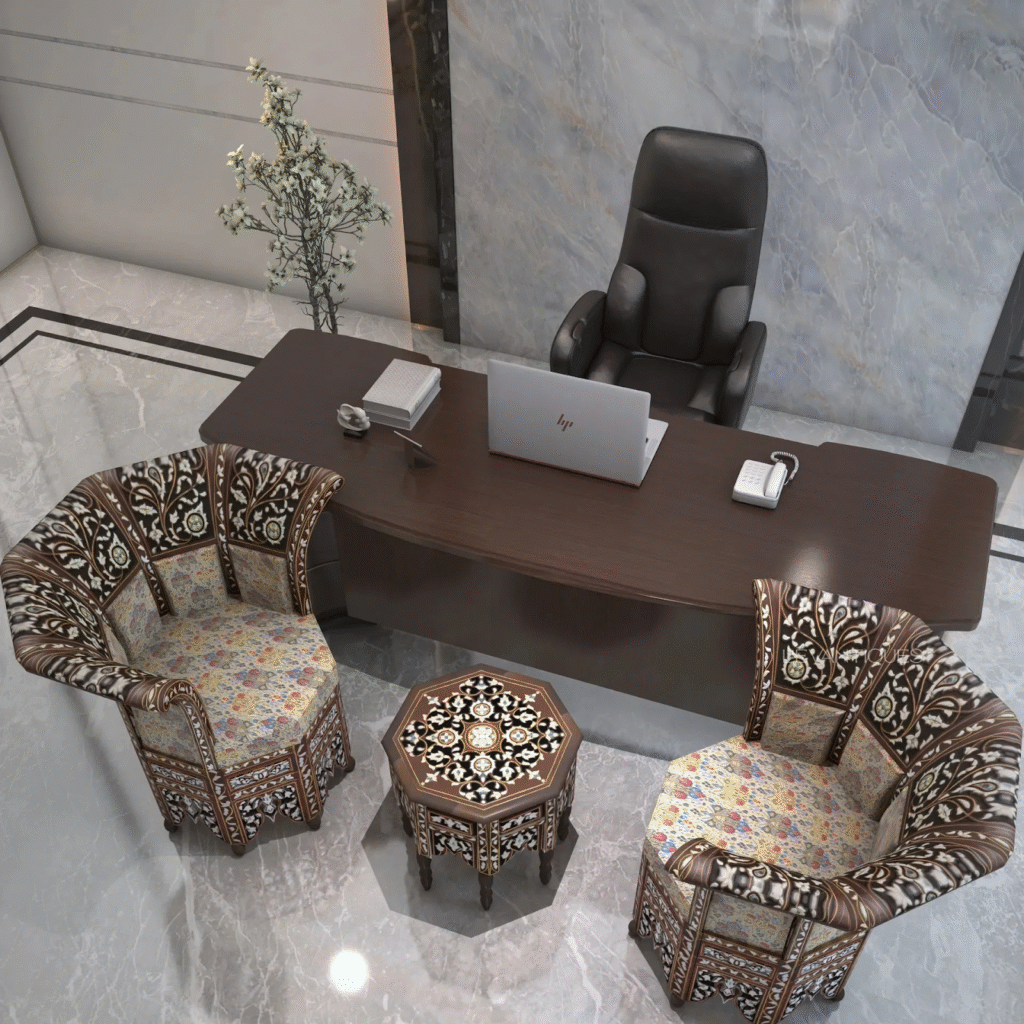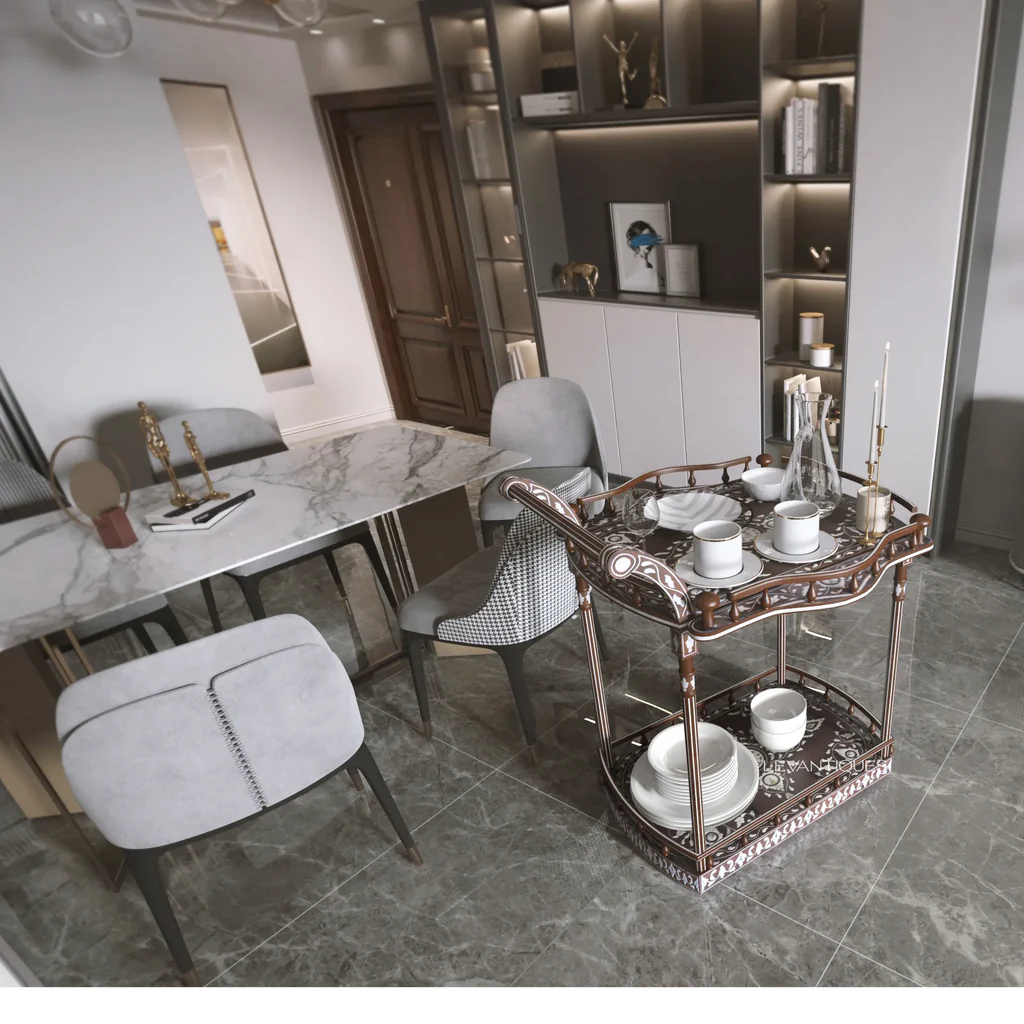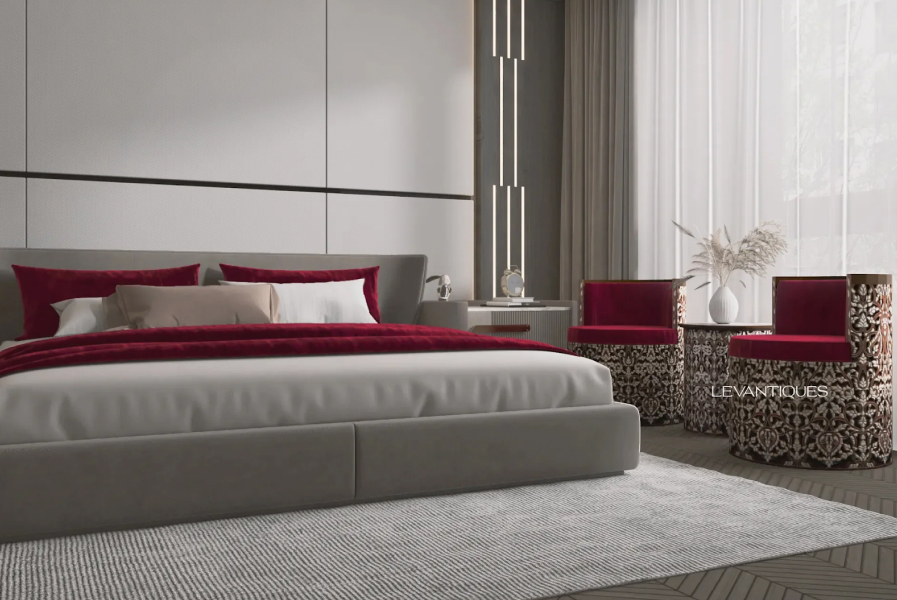How Can Interior Designers Blend Traditional Moroccan Sofas and Modern Decor for Luxurious, Contemporary Living Rooms?
Introduction
In recent years, Moroccan interior design has found its way into some of the most luxurious homes and offices around the world. From New York penthouses to seaside villas in Dubai, the charm of Moroccan furniture has captured the imagination of designers and homeowners alike. Its appeal lies in the perfect balance of comfort, artistry, and timeless style.

Picture a grand living room with soft, low-seating Moroccan sofas, walls adorned with a workspace where even a CEO office chair feels like part of the design story, and a bone inlay mirror that reflects warm light. This mix of elegance and practicality is why more people in cities like Los Angeles, Riyadh, Doha, and Kuwait City are choosing Moroccan-inspired elements for their modern homes.
What Makes Traditional Moroccan Sofas Unique?
Authentic Moroccan sofas, often referred to as majlis seating, are unlike anything else in the world of interior design. They are typically low to the ground, with generous, plush cushions that invite you to relax for hours. Upholstered in vivid textiles, embroidered patterns, and rich colors, they bring warmth and personality to any room. In traditional Moroccan interior decor, these sofas are the heart of the living space, where conversations, meals, and celebrations naturally gather.
Why Are Modern Designers Embracing Moroccan Sofas?
Today’s luxury interiors are about more than aesthetics – they tell a story. Designers from Miami to Abu Dhabi are turning to Moroccan interior style because it offers cultural depth, exceptional comfort, and an unmistakable artisanal touch. The rise of modern Moroccan interior design shows a desire to combine global influences with personal expression, often blending the intricate patterns of Moroccan inspired interiors with minimalist layouts. This approach softens contemporary spaces, giving them a lived-in warmth without losing sophistication.
What Modern Decor Elements Complement Moroccan Sofas?
Pairing Moroccan sofas with modern decor is all about balance. Here are a few elements that work beautifully:
- Neutral palettes – Soft beige, ivory, and stone tones let the sofa’s patterns shine.
- Clean lines – Sleek shelving, modern side tables, and minimalist frames create harmony.
- Contemporary lighting – A statement pendant or hidden LED strips add depth.
- Sleek Moroccan coffee tables – Combining traditional carvings with glass or metal tops bridges old and new.
Do’s and Don’ts:
- Do mix textures – smooth metal with woven fabrics, carved wood with glass.
- Do use modern art to break up pattern-heavy spaces.
- Don’t over-clutter – let the statement pieces breathe.
- Don’t force matching sets – variety gives Moroccan style decor its charm.
How to Blend Moroccan Sofas with Modern Decor: Step-by-Step Ideas

Blending Moroccan interior style with modern decor isn’t about following rigid rules – it’s about creating a space that feels both rich in culture and effortlessly livable. A traditional Moroccan sofa can be the hero piece, but how you place it and what you pair it with will decide whether your living room feels balanced or busy.
Room Layout Tips – Positioning Moroccan Sofas as Focal Points
Start by deciding where the eye should go when someone enters the room. In most Moroccan interior design living rooms, the sofa naturally becomes the centerpiece. Position it to face the main light source – whether that’s a large window in a Miami penthouse or a glass door overlooking the desert in Riyadh. Keep walkways clear so the seating area feels inviting, not cramped.
Mixing and Matching – Pairing with Modern Accents
To bridge the gap between tradition and today, pair your sofa with modern Moroccan side tables, an ottoman coffee table, or a sleek Moroccan accent chair. Mixing carved wood with glass or metal accents creates contrast without clashing. In Doha apartments, designers often pair low, patterned sofas with slim metallic shelving, while in Los Angeles homes, you might see them alongside neutral Scandinavian-inspired chairs.
Wall Decor – Adding Depth and Character
Walls are an easy way to merge styles. A Moroccan arch mirror can add instant architectural charm, while metallic wall fixtures and abstract art keep things current. If you prefer a softer touch, go for a large Moroccan mirror with subtle bone inlay details – it reflects light beautifully and doubles the sense of space.
What Accessories Elevate a Moroccan-Modern Living Room?

Accessories are the final layer that brings personality to your space. A Moroccan tray table can serve as both decor and a practical serving piece during gatherings. Decorative Moroccan vases in earthy tones or jewel colors add a pop of artistry to side tables and shelves. A plush, luxurious rug underfoot grounds the seating area, while handmade outdoor furniture brisbane – from lanterns to carved wooden boxes – make the space feel authentic.
When choosing textiles and patterns, mix bold motifs with understated solids. For example, if your sofa upholstery is richly patterned, opt for plain cushions in silk or linen. If the sofa is in a solid fabric, layer patterned throws or embroidered pillows to bring in texture and color. This approach works beautifully in spaces from a waterfront villa in Abu Dhabi to a Manhattan loft.
Real Project Inspiration – Moroccan Sofas in Modern Homes

1. Dubai Marina Apartment – A low, white Moroccan sofa was paired with gold-accent side tables and a mirrored wall to capture city lights. The designer kept the rug and drapes in soft beige to let the sofa and accessories shine.
2. Miami Beach House – Here, a deep-blue Moroccan wood coffee table anchored the seating area, surrounded by a patterned sofa, linen armchairs, and a statement Moroccan wall mirror. Light poured in from floor-to-ceiling windows, balancing the rich colors.
3. Doha Penthouse – A modern sectional-style Moroccan sofa in muted gray was accented with Moroccan tray tables and metallic lanterns. The space blended Qatari skyline views with traditional craftwork in a way that felt both personal and luxurious.
What made these projects succeed was a thoughtful mix of textures, a controlled color palette, and accessories that told a story without overwhelming the space.
Conclusion – Why This Blend Works
The beauty of combining Moroccan interior design with modern decor lies in the balance it creates – cultural depth with contemporary ease. You get a space that feels warm, lived-in, and full of personality, yet still polished enough for entertaining. Whether you’re a homeowner in Jeddah, an interior designer in New York, or an architect working on a Kuwait villa, the principles are the same: let your statement pieces breathe, mix styles with intention, and choose accessories that add meaning.
If you’re ready to explore Moroccan furniture, authentic Moroccan mirrors, or curated Moroccan home accessories, discover Levantiques’ collection – where tradition meets timeless style.
